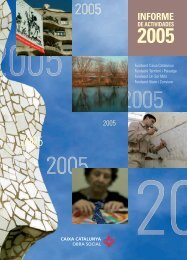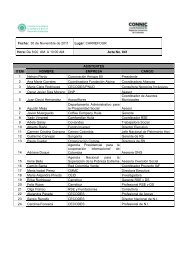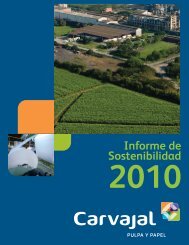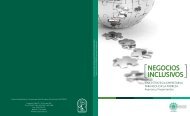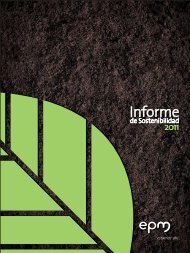Setting new standards - Friends Life
Setting new standards - Friends Life
Setting new standards - Friends Life
Create successful ePaper yourself
Turn your PDF publications into a flip-book with our unique Google optimized e-Paper software.
FINANCIAL STATEMENTS<br />
IFRS FINANCIAL STATEMENTS<br />
EEV SUPPLEMENTARY INFORMATION<br />
Notes to the consolidated accounts continued<br />
1. Accounting policies continued<br />
Joint ventures are those entities where the terms of the contractual<br />
agreement ensure that the parties involved jointly control the entity,<br />
notwithstanding that the Group’s share of the underlying assets and<br />
liabilities may be more than 50%. The Group recognises its interests<br />
in joint ventures using the equity method.<br />
Under the equity method, an investment is included as a single line<br />
item in the consolidated balance sheet as the Group’s share of the<br />
fair value of the investee undertaking’s net assets plus goodwill,<br />
which equates to the cost of the investment plus the Group’s share<br />
of post-acquisition reserves. The Group’s share of post-tax profits or<br />
losses is presented as a single line item in the consolidated income<br />
statement, adjusted for the effect of any fair value adjustments.<br />
1.3.2 Product classification<br />
(a) Insurance contracts<br />
Contracts under which the Group accepts significant insurance risk<br />
from another party (the policyholder), by agreeing to compensate the<br />
policyholder if a specified uncertain future event (the insured event)<br />
adversely affects the policyholder, are classified as insurance<br />
contracts. Under IFRS 4, insurance risk is risk other than financial risk.<br />
Financial risk is the risk of a possible future change in one or more of:<br />
a specified interest rate, security price, commodity price, foreign<br />
exchange rate, index of price or rates, a credit rating or credit index or<br />
other variable. Insurance contracts may transfer some financial risk.<br />
Once a contract has been classified as an insurance contract, it<br />
remains an insurance contract for the remainder of its lifetime, even<br />
if the insurance risk reduces significantly during this period. As a<br />
general guideline, the Group defines as significant insurance risk the<br />
possibility of having to pay benefits on the occurrence of an insured<br />
event that is more than 5% greater than the benefits payable if the<br />
insured event did not occur.<br />
(b) Investment contracts<br />
Policyholder contracts not considered insurance contracts under<br />
IFRS 4 are classified as investment contracts. Contracts classified as<br />
investment contracts are either unit-linked or contracts with<br />
Discretionary Participation Features (DPF). These are mainly unitised<br />
with-profits contracts.<br />
(c) Options and guarantees<br />
Options and guarantees are valued separately unless the option or<br />
guarantee itself meets the definition of an insurance contract, or it is a<br />
policyholder option to surrender an insurance contract for a fixed amount.<br />
For options and guarantees separated from the host contract, the<br />
Group measures them at fair value and includes the change in fair<br />
value in the income statement on the same basis as for its other<br />
embedded derivatives.<br />
1.3.3 Segment reporting<br />
Management reviews the Group’s operations on the basis of its key<br />
business activities or business segments. These are groups of<br />
assets or operations that provide products or services that are<br />
different in terms of risks and returns to those of other business<br />
segments. The Group therefore reports its primary segment<br />
information using business segments.<br />
Secondary segment information is reported using geographical<br />
segments. A geographical segment provides products or services<br />
within a particular economic environment that are subject to risks and<br />
returns that are different to those of other geographical segments.<br />
Further details of the segments selected by the Group are included<br />
in note 3.<br />
1.3.4 Foreign currency translation<br />
(a) Foreign currency transactions<br />
The Group’s presentation currency is sterling. Transactions in foreign<br />
currencies are translated to sterling at the foreign exchange rates ruling<br />
at the date of the transaction. Monetary assets and liabilities<br />
denominated in foreign currencies at the balance sheet date are<br />
translated to sterling at the exchange rate ruling at the balance sheet<br />
date, and any exchange differences arising are taken to the income<br />
statement. Non-monetary assets and liabilities measured at historical<br />
cost in a foreign currency are translated using the exchange rate at the<br />
date of the transaction and are not subsequently restated. Nonmonetary<br />
assets and liabilities stated at fair value in a foreign currency<br />
are translated at the rate on the date the fair value was determined.<br />
When a gain or loss on a non-monetary item is recognised directly in<br />
equity, any exchange component of that gain or loss is recognised<br />
directly in equity. Conversely, when a gain or loss on a non-monetary<br />
item is recognised in the income statement, any exchange<br />
component of that gain or loss is recognised in the income statement.<br />
Foreign exchange adjustments recognised in equity are reported in the<br />
Group’s foreign currency translation reserve within retained earnings<br />
and reported in the statement of recognised income and expense.<br />
(b) Overseas subsidiaries<br />
The assets and liabilities of overseas subsidiaries, including goodwill<br />
and intangible assets attributable to the acquisition of the overseas<br />
subsidiary, and fair value adjustments arising on consolidation, are<br />
translated to sterling at foreign exchange rates ruling at the balance<br />
sheet date. The revenues and expenses of overseas subsidiaries are<br />
translated to sterling at average foreign exchange rates for the year.<br />
Foreign exchange differences arising on the translation to sterling<br />
are classified as equity movements and recognised in the Group’s<br />
foreign currency translation reserve and reported in the statement of<br />
recognised income and expense. These exchange differences are<br />
recognised in the income statement in the period in which the<br />
overseas subsidiary is disposed of.<br />
1.3.5 Revenue recognition<br />
(a) Premiums<br />
Premium income in respect of single premium business, <strong>new</strong><br />
generation group pensions business and pensions business not<br />
subject to contractual regular premiums, is accounted for when the<br />
premiums are received.<br />
For all other classes of business, premium income is accounted for<br />
in the year in which it falls due.<br />
Reinsurance premiums are accounted for when due for payment.<br />
76 <strong>Friends</strong> Provident Annual Report & Accounts 2006







